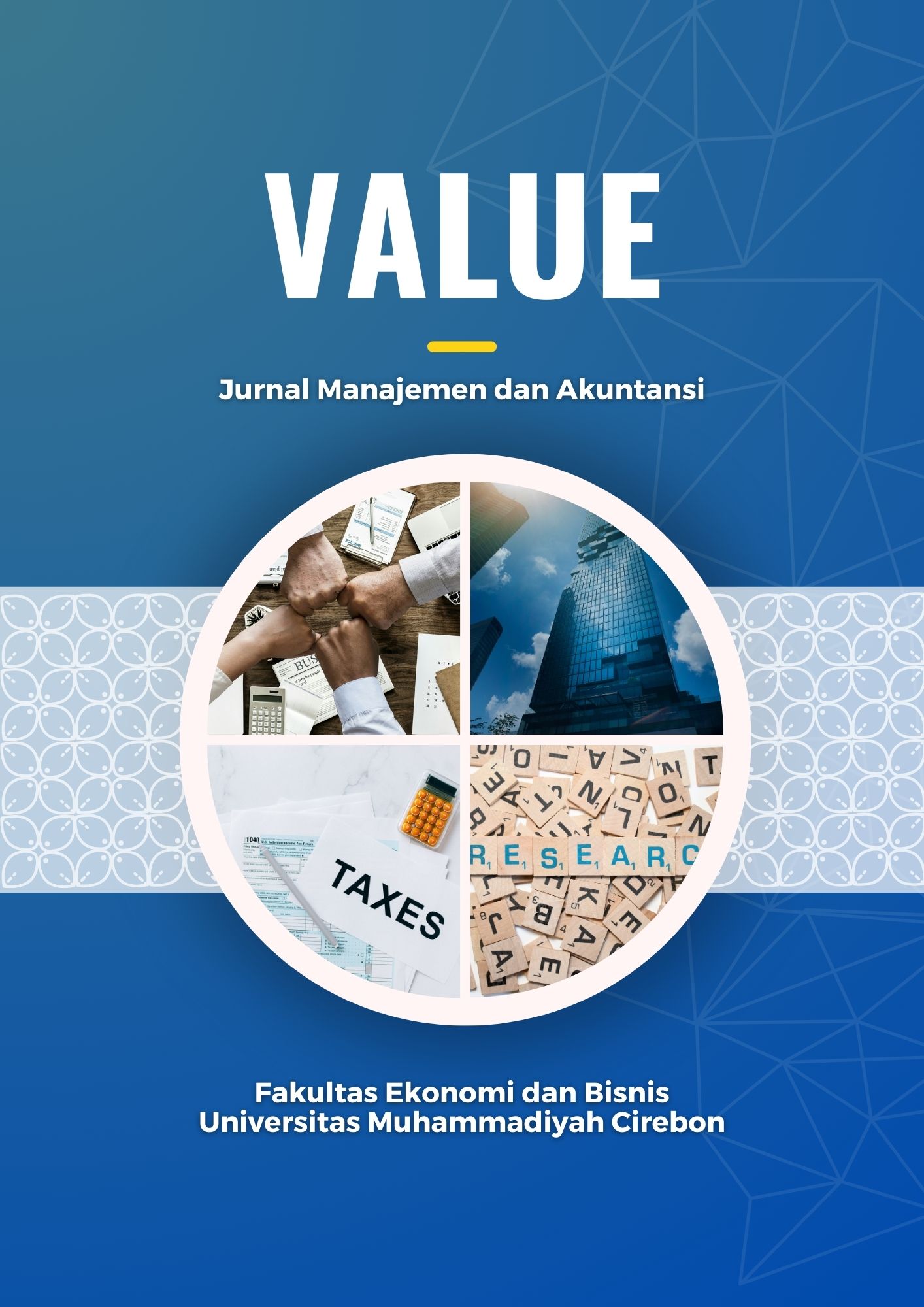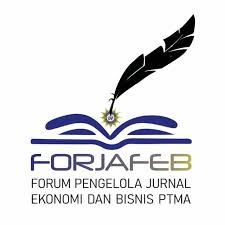Mengoptimalkan Produktivitas Karyawan Melalui Work-Life Balance, Authentic Leadership Dan Self-Efficacy
DOI:
https://doi.org/10.32534/jv.v20i2.7612Keywords:
Employee Productivity, Work-Life Balance, Authentic Leadership,, Self-Efficacy, Human Resource ManagementAbstract
In the midst of the increasingly competitive dynamics of the modern workplace, companies are required to ensure employee productivity without sacrificing well-being and Work-Life Balance. Key challenges currently faced include high work pressure, uncertain work environments, and the need for leaders capable of building trust and empowering teams authentically. This study aims to analyze the extent to which Work-Life Balance, Authentic Leadership, and Self-efficacy are related to employee productivity at PT Campus Data Media. Using a quantitative approach and sampling methods tailored to the research context, data were analyzed through a series of statistical tests. The results show that all three variables simultaneously contribute to increased productivity. However, partially, only Authentic Leadership style has a significant relationship with employee productivity. Meanwhile, Work-Life Balance and self-efficacy do not have a significant relationship. These findings emphasize the importance of honest, open leadership and the ability to build healthy relationships with employees, especially for the younger generation who value authenticity in leadership. This study also enriches theoretical insights in the field of human resource management and provides recommendations for companies to be more responsive to employee needs through adaptive and humanistic work policies.
References
Ali AlHazemi, A., & Ali, W. (2016). The Notion Of Work Life Balance, Determining Factors, Antecedents And Consequences: A Comprehensive Literature Survey. International Journal of Academic Research and Reflection, 4(8). www.idpublications.org
Allen, T. D., Herst, D. E. L., Bruck, C. S., & Sutton, M. (2000). Consequences Associated With Work-to-Family Conflict: A Review and Agenda for Future Research. Journal of Occupational Health Psychology, 5(2), 278–308. https://doi.org/10.1037/1076-899B.5.2.278
Anakonda, C. N. R. M., & Pesudo, D. A. A. (2025). Pengaruh Authentic Leadership dan Work Engagement Terhadap Kualitas Audit. Journal of Accounting and Finance Management, 6(1), 325–360. https://doi.org/10.38035/jafm.v6i1
Anhar, R. A., Suryaningsih, A., & Fadillah. Raysha N.P. (2024). Pengaruh Fleksibilitas Jam Kerja dan Work Life Balance terhadap Peningkatan Produktivitas Karyawan Gen Z. Jurnal Menejemen Dan Bisnis Ekonomi, 3(1), 233–243. https://doi.org/10.54066/jmbe-itb.v3i1.2760
Apriliani, N. K., & Sriathi, A. A. A. (2019). Pengaruh Pemberdayaan, Kerjasama Tim dan Pelatihan Terhadap Produktivitas Kerja Karyawan di Spa Santrian Bali. E-Jurnal Manajemen Universitas Udayana, 8(11), 6867. https://doi.org/10.24843/ejmunud.2019.v08.i11.p24
Avolio, B. J., & Gardner, W. L. (2005). Authentic leadership development: Getting to the root of positive forms of leadership. Leadership Quarterly, 16(3), 315–338. https://doi.org/10.1016/j.leaqua.2005.03.001
Babu, V., & Ansari, A. H. (2010). Strategic Management of Human Resources:A Response to Globalization and Business Performance. Srusti Managemen Review, 11–22. https://www.researchgate.net/publication/320565376
Badaruddin, Surianto, & Fatmasari. (2024). Work-Life Balance and Professional Development: Their Impact on Employee Performance. PARADOKS Jurnal Ilmu Ekonomi, 7(4), 409–424. https://doi.org/10.57178/paradoks.v7i4.986
Bandura, A. (1982). Self-Efficacy Mechanism in Human Agency. American Psychological Association, 37(2), 122–147. https://doi.org/10.1037/0003-066X.37.2.122
Bandura, A. (1997). Self-Efficacy : The Excercise of Control. New York: W.H. Freeman and Company.
Baquero, A. (2023). Authentic Leadership, Employee Work Engagement, Trust in the Leader, and Workplace Well-Being: A Moderated Mediation Model. Psychology Research and Behavior Management, 16, 1403–1424. https://doi.org/10.2147/PRBM.S407672
Becker, G. S. (1964). Human capital is that humans are not just resources but capital that yields returns, and any expenditure to develop the quality and quantity of that capital is an investment (1st ed.). National Bureau of Economic Research.
BPS. (2023). Indeks Pembangunan Teknologi Informasi dan Komunikasi 2022. Badan Pusat Statistik.
Calvin Ong, H. L., & Jeyaraj, S. (2014). Work–life interventions: Differences between work–life balance and work–life harmony and its impact on creativity at work. SAGE Open, 4(3). https://doi.org/10.1177/2158244014544289
Dawang, K. R. T., & Genuba, R. L. (2024). International Journal Of Innovative Research In Multidisciplinary Education Authentic Leadership And Work Engagement Of School Heads As Mediators Of Self-Efficacy. Journal Of Innovative Research In Multidisciplinary Education, 3(9), 1530–1537. https://doi.org/10.58806/ijirme.2024.v3i9n13
Deloitte. (2022). Gen Z and Millennial Survey Reveals Two Generations Striving for Balance and Advocating for Change. Deloitte Touche Tohmatsu Limited.
Duarte, A. P., Ribeiro, N., Semedo, A. S., & Gomes, D. R. (2021). Authentic Leadership and Improved Individual Performance: Affective Commitment and Individual Creativity’s Sequential Mediation. Frontiers in Psychology, 12. https://doi.org/10.3389/fpsyg.2021.675749
Emuwa, A. (2013). Authentic Leadership: Commitment to Supervisor, Follower Empowerment, and Procedural Justice Climate. Emerging Leadership Journeys, 6(1).
Fatmawati, C. D., & Mansyur, A. (2024). Turnover Intention : Apakah Workload And Work Life Balance Memiliki Peran? JIMEA, 8(3), 402–415.
Felstead, A., & Henseke, G. (2017). Assessing the growth of remote working and its consequences for effort, well-being and work-life balance. New Technology, Work and Employment, 32(3), 195–212. https://doi.org/10.1111/ntwe.12097
Fink, M., Koller, M., Gartner, J., Floh, A., & Harms, R. (2020). Effective entrepreneurial marketing on Facebook – A longitudinal study. Journal of Business Research, 113, 149–157. https://doi.org/10.1016/j.jbusres.2018.10.005
Gabarrell-Pascuet, A., García-Mieres, H., Giné-Vázquez, I., Moneta, M. V., Koyanagi, A., Haro, J. M., & Domènech-Abella, J. (2023). The Association of Social Support and Loneliness with Symptoms of Depression, Anxiety, and Posttraumatic Stress during the COVID-19 Pandemic: A Meta-Analysis. In International Journal of Environmental Research and Public Health (Vol. 20, Issue 4). MDPI. https://doi.org/10.3390/ijerph20042765
Gibran, M. F., Khaeruman, K., & Abduh, E. M. (2024). Pengaruh Work Life Balance Dan Stres Kerja Terhadap Produktivitas Kerja Karyawan Di PT Pigeon Indonesia. INVESTASI : Inovasi Jurnal Ekonomi Dan Akuntansi, 2(3), 110–118. https://doi.org/10.59696/investasi.v2i3.48
Greenhaus, & Beutell. (1985). Sources of Conflict between Work and Family Roles (Vol. 10). The Academy of Management Review.
Greenhaus, J. H., & Allen, T. D. (2011). Work-Family Balance: A Review and Extension of the Literature. In J. C. Quick & L. E. Tetrick (Eds.), Occupational Health Psychology (2nd ed., pp. 165–183). American Psychological Association. https://www.researchgate.net/publication/259280583
Haar, J. M., Russo, M., Suñe, A., & Ollier-Malaterre, A. (2014). Outcomes of work-life balance on job satisfaction, life satisfaction and mental health: A study across seven cultures. Journal of Vocational Behavior, 85(3), 361–373. https://doi.org/10.1016/j.jvb.2014.08.010
Hair, J. F., Black, W. C., Babin, B. J., & Anderson, R. E. (2019). Multivariate Data Analysis (8th ed.). British Library Cataloguing. www.cengage.com/highered
Hoeven, C. L. ter, & Zoonen, W. van. (2015). Flexible work designs and employee well-being: Examining the effects of resources and demands. New Technology, Work and Employment, 30(3), 237–255. https://doi.org/10.1111/ntwe.12052
Judge, T. A., Jackson, C. L., Shaw, J. C., Scott, B. A., & Rich, B. L. (2007). Self-efficacy and work-related performance: The integral role of individual differences. Journal of Applied Psychology, 92(1), 107–127. https://doi.org/10.1037/0021-9010.92.1.107
Kaiser, H. F. (1974). An index of factorial simplicity. Psychometrika, 39(1), 31–36. https://doi.org/10.1007/BF02291575
Kamila, I., & Nurhasanah, N. (2024). Pengaruh Self Efficacy, Perilaku Kerja Inovatif Dan Knowledge Sharing Terhadap Kinerja Karyawan. Jurna Manajemen, 1, 10–21. https://doi.org/10.37817/jurnalmanajemen.v11i1
Kinaryosih, A., Pradita, A., Febrianti, N., Khoeri, M., & Rizana, D. (2025). Systematic Literature Review The Role Of Authentic Leadership And Organizational Commitment In Improving Employee Work Peformance In The Era Of Digital Transformation. Neraca Manajemen, Ekonomi, 14(12). https://doi.org/10.8734/mnmae.v1i2.359
Luthans, F., & Avolio, B. (2019). Authentic Leadership Development. In Upward Spirals and Positive Change (Vol. 16, pp. 242–271). berrett - Koehler.
Maharani, D., Nurmala, R., & Saori, S. (2024a). Pengaruh Efikasi Diri dan Kerjasama Tim Terhadap Produktifitas Kerja Karyawan. Jurnal Bisnis & Akuntansi, 14(2). https://doi.org/10.24929/feb.v14i2.3442
Maharani, D., Nurmala, R., & Saori, S. (2024b). Pengaruh Efikasi Diri Dan Kerjasama Tim Terhadap Produktivitas Kerja Karyawan. Jurnal Bisnis & Akuntansi, 14(2), 151–161. https://doi.org/10.24929/feb.v14i2.3442
Malhotra, Naresh. K. (2010). Marketing Research: An Applied Orientation (6th ed.). Pearson Education.
Mamluka, & Andjarwati, T. (2024). Pengaruh Kepemimpinan Otentik, Motivasi Kerja, dan Budaya Organisasi terhadap Kinerja Karyawan pada CV. Litera Jannata Perkasa Kota Surabaya. Neraca Manajemen, Ekonomi, 11(1). https://doi.org/10.8734/mnmae.v1i2.359
Marecki, ?. (2024). Impact of work-life balance on employee productivity and well-being. Journal of Managemen and Financial Science, 16(50), 165–178. https://doi.org/10.33119/JMFS.2023.50.9
McKinsey. (2023). Reframing employee health: Moving beyond burnout to holistic health. McKinsey and Company.
Nur’aini, S., & Laili, J. (2024). Pengaruh Kepemimpinan Autentik Terhadap Komitmen Organisasi Pada Pimpinan Organisasi Perempuan Melalui Readiness to Change. Jurnal Ilmiah Fakultas Psikologi Universitas Yudharta Pasuruan, 11(2), 447–457. https://doi.org/10.35891/jip.v11i2
Nurlianti, N., Hidayati, T., & Wijaya, A. (2023). The Effect of Organizational Culture and Authentic Leadership on Affective Commitment through Job Satisfaction. Journal of Madani Society, 2(2), 128–145. https://doi.org/10.56225/jmsc.v2i2.254
Octoriani, A. C. N., Trirahayu, D., & Nisa, C. (2021). Pengaruh Work-Life Balance Dan Job Crafting Terhadap Work Engagement Karyawan PT Bank Tabungan Negara (PERSERO) TBK. JIMP, 1(1), 40–55. https://journal.univpancasila.ac.id/index.php/JIMP
Pratamasari, L. H., & Puryandani, S. (2023). Pengaruh Kepemimpinan Otentik Terhadap Kinerja Pegawai Dengan Komitmen Organisasional Sebagai Variabel Mediasi. Prosiding Seminar Nasional Dan Paper STIE Wiwaha, 1, 316–335. https://doi.org/10.32477/semnas.v1i1.648
Rego, P., Lopes, M. P., & Nascimento, J. L. (2016). Authentic leadership and organizational commitment: The mediating role of positive psychological capital. Journal of Industrial Engineering and Management, 9(1), 129–151. https://doi.org/10.3926/jiem.1540
Robbins, S. P., & Judge, T. A. (2011). Organizational Behavior (17th ed.). Pearson Education. http://www.pearsonmylabandmastering.com
Silotonga, M. R., & Hutapea, J. Y. (2022). Pengaruh Ukuran KantorAkuntanPublik, Opini Audit, Pergantian Manajemen, dan Financial Distress pada Auditor Switching (Pada Perusahhan Manufactur yang Terdaftardi BEI periode 2016-2020). Journal of Comprehensive Science, 1(2), 194–200. https://doi.org/10.59188/jcs.v1i2.34
Stajkovic, A. D., & Luthans, F. (1998). Self-Efficacy and Work-Related Performance: A Meta-Analysis. Psychological Bulletin, 124(2), 240–261. https://doi.org/10.1037/0033-2909.124.2.240
Suhana, S., Mansyur, A., & Rachmawati, L. (2022). Efforts to Increase Student Academic Achievement Through Knowledge Sharing. Atlantis Press International B.V., 175, 53–57. https://doi.org/10.2991/aisr.k.220201.010
Uki Diana, P., Komariah Hildayanti, S., & Handayani, S. (2025). The Impact of Technostress, Self-Efficacy, and Work-Life Balance on Employee Performance at LLDIKTI Region II. Human Resource Management JENIUS, 8(3), 351–357. https://doi.org/10.32493/JJDP.v8i3.48475
Walumbwa, F. O., Avolio, B. J., Gardner, W. L., Wernsing, T. S., & Peterson, S. J. (2008). Authentic leadership: Development and validation of a theory-based measure. Journal of Management, 34(1), 89–126. https://doi.org/10.1177/0149206307308913
William, A. A., & Singh, K. (2024). The impact of work–life balance and flexible work arrangements on non-financial organisational performance. International Social Science Journal, 74(254), 1259–1279. https://doi.org/10.1111/issj.12511
Williams, D. M., & Rhodes, R. E. (2016). The confounded self-efficacy construct: conceptual analysis and recommendations for future research. Health Psychology Review, 10(2), 113–128. https://doi.org/10.1080/17437199.2014.941998
Wulandari, S., & Kuswino, M. (2024). Kajian Literatur :Hubungan Antara Keseimbangan Hidup Kerja dan Produktifitas Karyawan. Neraca Manajemen, Ekonomi, 11(12).
Zaky, M. (2023). Dampak Keseimbangan Kehidupan Kerja Dan Kehidupan Pribadi Terhadap Kepuasan Dan Kinerja Karyawan. BRANDING : Jurnal Ilmiah Sunan Gunung Djati Bandung, 72–86. https://www.journal.uinsgd.ac.id/index.php/branding


















